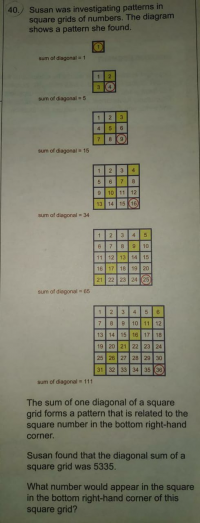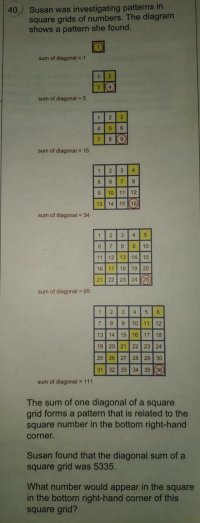pattern in a number table
- Thread starter nanase
- Start date
D
Deleted member 4993
Guest
Please show us what you have tried and exactly where you are stuck.Can somebody help me in finding the pattern of the sum of the diagonal?
I noticed the bottom right number is a square number
Thank you for your help
View attachment 33772
Please follow the rules of posting in this forum, as enunciated at:
READ BEFORE POSTING
Please share your work/thoughts about this problem

yes sir, I have tried it, I work out that the number in the bottom right is a square number, but I am having problems finding the total of the diagonal.
How do i start finding the equation of the total of the diagonal, that's what i am stuck with
How do i start finding the equation of the total of the diagonal, that's what i am stuck with
D
Deleted member 4993
Guest
If the bottom-right number is x^2, then the first # of the sequence is "x' (the number in the top right corner),yes sir, I have tried it, I work out that the number in the bottom right is a square number, but I am having problems finding the total of the diagonal.
How do i start finding the equation of the total of the diagonal, that's what i am stuck with
the second # is [x +(x-1)],
the third # is ?
Can you write the whole sequence in terms of 'x'?
This is a problem in recognizing patterns. There are two ways to discover possible patterns. One is to experiment, meaning try things. The other way is try to figure out what patterns may make sense. Or you can try both.yes sir, I have tried it, I work out that the number in the bottom right is a square number, but I am having problems finding the total of the diagonal.
How do i start finding the equation of the total of the diagonal, that's what i am stuck with
Why is the southeast cell always a square number? Why does that make sense? To answer that question requires thinking a bit about how the squares are constructed, to find the pattern for the squares. Maybe that will tell us something about the southwest cells.
Or you could make a table of the value of southwest squares in one column and the value of the southeast squares in another column. Do you see any relationship there?
In short, try some things.
I realised that for n X n table, the number in the bottom left would be x + (n-1)(x-1) and equate it with 5335, where x is the top-right number and n is the sequence, but i end up with 2 variables?If the bottom-right number is x^2, then the first # of the sequence is "x' (the number in the top right corner),
the second # is [x +(x-1)],
the third # is ?
Can you write the whole sequence in terms of 'x'?
D
Deleted member 4993
Guest
How do 'x' & 'n' depend on each other?I realised that for n X n table, the number in the bottom left would be x + (n-1)(x-1) and equate it with 5335, where x is the top-right number and n is the sequence, but i end up with 2 variables?
What does x represent? We cannot help you if you do not say what things mean.I realised that for n X n table, the number in the bottom left would be x + (n-1)(x-1) and equate it with 5335, where x is the top-right number and n is the sequence, but i end up with 2 variables?
In an n by n table with each cell increasing by 1, the numbers in the leftmost cell of row t is 1 + n(t - 1), where 1 1≤t≤n. Lesson 1: label things.
Lesson 2: Check things. n = 1, the leftmost cell is indeed 1 + 1(1 - 1) = 1.
n = 2, the leftmost cell of row 2 is 1 + 2(2 - 1) = 3.
n = 3, the leftmost cell of row 1 is 1 + 3(1 - 1) = 1.
n = 3, the leftmost cell of row 2 is 1 + 3(2 - 1) = 4.
n = 3, the leftmost cell of row 3 is 1 + 3(3 - 1) = 7.
Looks good and makes sense.
So the number in the leftmost cell of row n is 1+n(n−1)=n2−n+1.
So yes, solve n2−n+1=5335.
EDIT CORRECTION Finding the value of the corner cell is not what is needed. You are to find a sum.
Last edited:
Since I messed up so badly, let me give a far more detailed hint
If n = 1, the relevant sum is 1.
If n = 2, the relevant sum is 5
If n = 3, the relevant sum is is 15
If n = 4, the relevant sum is 34.
If n = 5, the relevant sum is 65
If n = 6, the relevant sum is 111
Take first differences. No joy.
Take second differences. No joy.
Take third differences. Looks like a cubic.
Do you know how to find it using the three first differences?
I truly apologize for getting off track in my second post
If n = 1, the relevant sum is 1.
If n = 2, the relevant sum is 5
If n = 3, the relevant sum is is 15
If n = 4, the relevant sum is 34.
If n = 5, the relevant sum is 65
If n = 6, the relevant sum is 111
Take first differences. No joy.
Take second differences. No joy.
Take third differences. Looks like a cubic.
Do you know how to find it using the three first differences?
I truly apologize for getting off track in my second post
Dr.Peterson
Elite Member
- Joined
- Nov 12, 2017
- Messages
- 16,808
Here's what I did:
I'm taking n as the number of cells per row (the side length of the square).
First, I observed that the diagonal forms an arithmetic sequence, so its sum is just n times the average of the upper right and lower left (the ends of the sequence). That average, by the way, is the middle cell, if there is one.
So I wrote expressions for those cells, and got an expression for the sum from that.
The result is indeed a cubic; that would be hard to actually solve, but we can approximate it by just taking a cube root and checking that the rounded result is correct.
Then go from n to the lower right cell, and you're done.
By the way, they only say "one diagonal", without identifying it; you are expected to see from the picture which diagonal they mean, namely the rising one. But ... what would happen if they mean the other, falling, diagonal? Why is that true?
I'm taking n as the number of cells per row (the side length of the square).
First, I observed that the diagonal forms an arithmetic sequence, so its sum is just n times the average of the upper right and lower left (the ends of the sequence). That average, by the way, is the middle cell, if there is one.
So I wrote expressions for those cells, and got an expression for the sum from that.
The result is indeed a cubic; that would be hard to actually solve, but we can approximate it by just taking a cube root and checking that the rounded result is correct.
Then go from n to the lower right cell, and you're done.
By the way, they only say "one diagonal", without identifying it; you are expected to see from the picture which diagonal they mean, namely the rising one. But ... what would happen if they mean the other, falling, diagonal? Why is that true?
D
Deleted member 4993
Guest
| Hint: Sum of squares of n natural numbers | [n(n+1)(2n+1)] / 6 |
|---|
D
Deleted member 4993
Guest
The sum S = x + [x+(x-1)] + [x + 2*(x-1)] +[x+3*(x-1)} .... + [x + (x-1)(x-1)] = x*x +(x-1)*[1+2+...(x-1)] = x^2 + (x-1)*x*(x-1)/2 = (x^3 + x) / 2Can somebody help me in finding the pattern of the sum of the diagonal?
I noticed the bottom right number is a square number
Thank you for your help
View attachment 33772
where the bottom-right-corner number of the table is x^2
Check
For the given table x = 6 and S = 36 + 25*3 = 111
Sum of diagonal numbers = 6 + 11 + 16 + 21 + 26 + 31 = 111 .................... checks
n2−n+1=5335. solving for n, then squaring it, would also give me the answer for the bottom right value is it?The sum S = x + [x+(x-1)] + [x + 2*(x-1)] +[x+3*(x-1)} .... + [x + (x-1)(x-1)] = x*x +(x-1)*[1+2+...(x-1)] = x^2 + (x-1)*x*(x-1)/2
where the bottom-right-corner number of the table is x^2
Check
For the given table x = 6 and S = 36 + 25*3 = 111
Sum of diagonal numbers = 6 + 11 + 16 + 21 + 26 + 31 = 111 .................... checks
D
Deleted member 4993
Guest
That is incorrect - read the response #11 and #12.n2−n+1=5335. solving for n, then squaring it, would also give me the answer for the bottom right value is it?
i focused on that, and now somebody said it's wrong, i am getting more lost, can somebody explain why?That is incorrect - read the response #11 and #12.
I am lost in the take first differences. no joySince I messed up so badly, let me give a far more detailed hint
If n = 1, the relevant sum is 1.
If n = 2, the relevant sum is 5
If n = 3, the relevant sum is is 15
If n = 4, the relevant sum is 34.
If n = 5, the relevant sum is 65
If n = 6, the relevant sum is 111
Take first differences. No joy.
Take second differences. No joy.
Take third differences. Looks like a cubic.
Do you know how to find it using the three first differences?
I truly apologize for getting off track in my second post
take third differences. looks like a cubic, where is the cubic coming from? third differences mean 34-15? or 15-5?
how do i find the first 3 differences?
D
Deleted member 4993
Guest
What method/s have you been taught to derive the polynomial expression passing through a set of points ?
for reference look into:
en.wikipedia.org/wiki/Lagrange_polynomial ,
or Newton interpolation polynomial:
for reference look into:
en.wikipedia.org/wiki/Lagrange_polynomial ,
or Newton interpolation polynomial:
en.wikipedia.org/wiki/Newton_polynomial (and many others).
Last edited by a moderator:
I am reconstructing from beginning now
top right cell is n
bottom right cell is n squared
bottom left cell is n squared - n + 1
i just need to work out the sum of the diagonal from top right to bottom left in an equation and i am stuck there
top right cell is n
bottom right cell is n squared
bottom left cell is n squared - n + 1
i just need to work out the sum of the diagonal from top right to bottom left in an equation and i am stuck there

